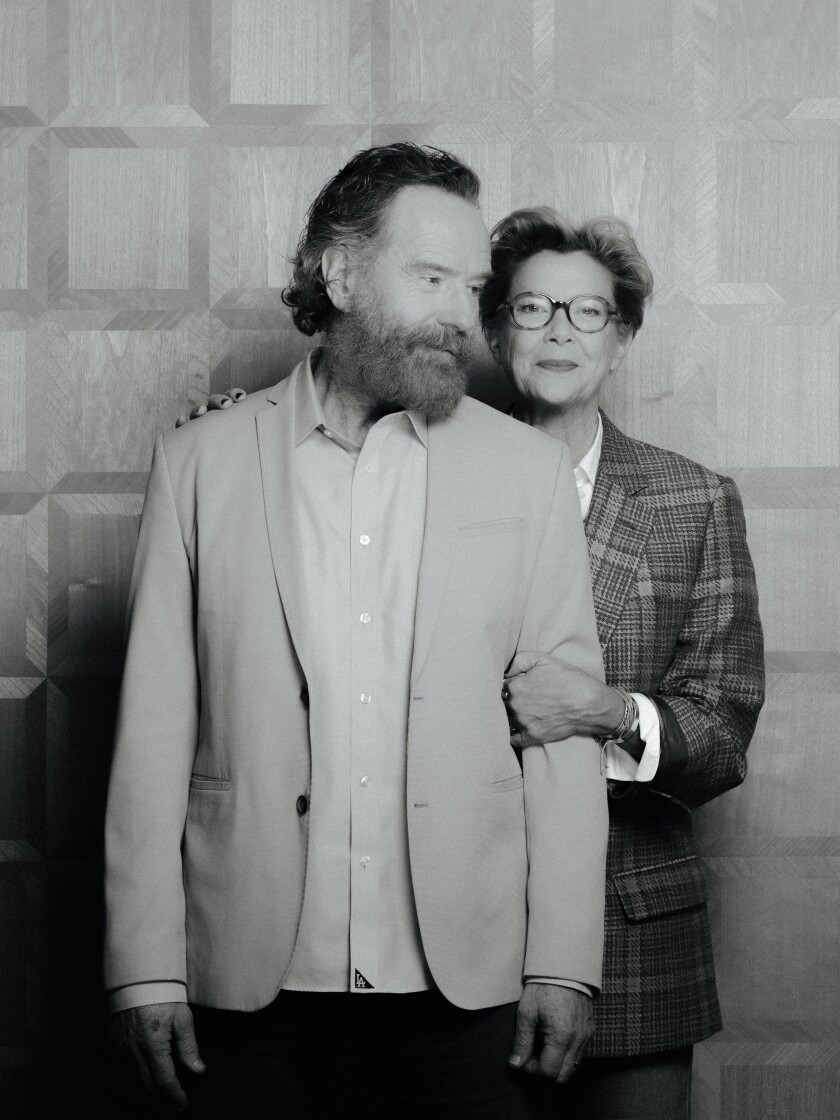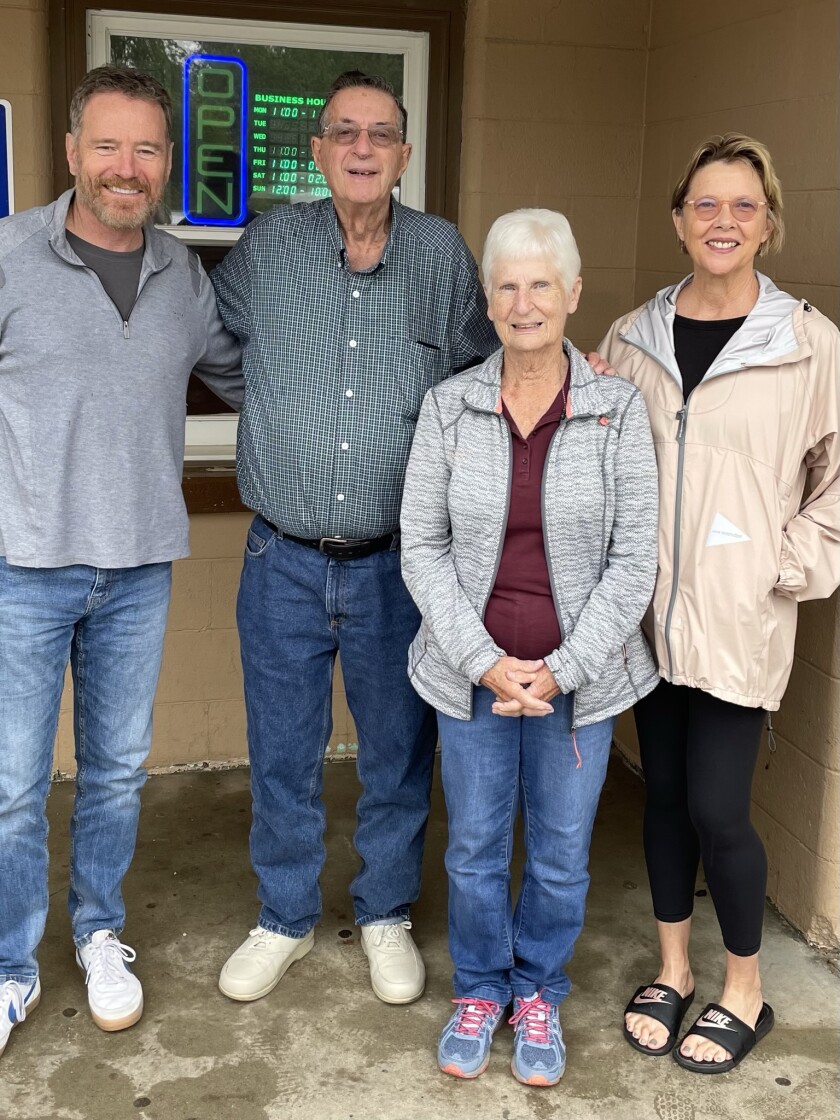
Bryan Cranston and Annette Bening star in “Jerry and Marge Go Large.”
(Myung J. Chun / Los Angeles Times)
Some people spend their whole lives fantasizing about winning the lottery. Jerry Selbee figured out how to actually do it in less time than it takes to make a cup of coffee.
In 2003, Selbee had recently retired and settled down with his wife, Marge, in the sleepy, one-stoplight town of Evart, Mich. (pop. 1,900) when one morning he came across a brochure in a convenience store for a state lottery game called Winfall. Reading the fine print, Selbee — a math whiz who had spent much of his career as a materials analyst at a Kellogg’s cereal factory — quickly realized that the lottery had a mathematical flaw that would mean guaranteed winnings if he bought enough tickets.
“I looked at the odds, I looked at what the payoff would be and I did a risk-reward analysis,” the plain-spoken, pragmatic Selbee, who is now in his 80s, says by phone from his Michigan home. “It took me less than two minutes to figure out that that game could be profitable.”
After Jerry tested out his theory, winning nearly $16,000, he and Marge began to spend countless hours buying and poring over thousands of tickets in the Winfall game and, later, a similarly structured lottery in Massachusetts. As their winnings started to accumulate, they set up a corporation called GS Investment Strategies LLC and invited a couple dozen family members and friends in Evart to join. By the time both lotteries had been shut down in 2012, the Selbees and their partners had grossed more than $26 million from the venture.
Then life for the Selbees grew quiet again, just the way they like it. Until Hollywood came calling.
The Selbees’ story, as chronicled in a 2018 Huffington Post article by Jason Fagone, has become the inspiration for the new movie “Jerry & Marge Go Large,” now streaming on Paramount+. Oscar nominees Bryan Cranston and Annette Bening star as the couple in the gently comic feel-good film, which is intended to provide a soothing, cynicism-free balm for audiences in these troubled times.

Bryan Cranston, left, as Jerry Selbee and Annette Bening as Marge Selbee in “Jerry & Marge Go Large” streaming on Paramount+.
(Jake Giles Netter / Paramount+)
“‘Jerry & Marge Go Large’ is not a story that is going to change anyone’s life, but you know what? It could change your day,” says Cranston. “Coming out of COVID, it feels like the time is right for this. We need a little breath-mint kind of entertainment just to feel better and connect again.”
For Hollywood, a heartwarming, too-good-to-be-true story that happens to be true can be as precious as a winning lottery ticket. After the publication of the Huffington Post article, the Selbees’ story quickly became a hot commodity, with at least 17 bidders vying for the rights.
“It just exploded,” says “Jerry & Marge” screenwriter Brad Copeland, who set about chasing the rights with “The Blind Side” producer Gil Netter. “There were different directors, there was Scarlett Johansson calling the family — there was a lot of interest because it is a great story.”
Reading Copeland’s script amid the grim headlines of 2020, director David Frankel, whose credits include “The Devil Wears Prada” and “Marley & Me,” immediately sparked to it. What the story might have lacked in thrills — no FBI agents kicking down doors, no over-the-top greed and extravagance a la “The Wolf of Wall Street” — it more than made up for in homespun charm. (The film does take a few small liberties with the real story, shifting the action to the present and amping up the conflict between the Selbees and a group of college students who also discovered the lottery’s loophole.)
“The idea of two people over 60 finding a new adventure that reinvigorated their romance and their town seemed like the perfect antidote to the pandemic,” Frankel says. “That earnestness was important. They’re making money, which in many other contexts is the root of all evil. But here, it’s doing a lot of good.”
After spending a few days with the Selbees before shooting began, Cranston and Bening were even more determined to do justice to their salt-of-the-earth values and more than 60-year marriage.

Bryan Cranston, left, and Annette Bening with the real-life people they portray, Jerry and Marge Selbee.
(Paramount+)
“Marge didn’t have stars in her eyes or anything, which I just loved about her,” says Bening. “She’s tough — she raised six kids and her family called her Marge the Sarge. But with Jerry there’s a little twinkle there, and she genuinely enjoyed their adventure.”
For Cranston, Selbee represented the moral antithesis of his turn as drug kingpin Walter White in “Breaking Bad,” who employed a similarly exacting intellect to become a criminal mastermind. “When you’re doing research like this, you just want to be open to receiving the essence of people that you’re looking at,” says Cranston. “There was a lot of time when we were just sitting with Jerry and Marge on the back porch rocking away or going for a drive or having a meal with them somewhere. It was just really sweet.”
Sweet as they may be, folksy Midwestern retirees are not generally considered the sexiest subject matter for Hollywood — or the most desirable moviegoing demo. Going against that youth-obsessed grain, “Jerry & Marge” is directly pitched at a segment of the public that the industry often neglects. The film is the fledging release from producer Amy Baer’s Landline Pictures, a label that launched last year under independent studio MRC Film to develop film and TV projects for an over-50 audience.
“It keeps happening over and over that people don’t realize this audience exists and goes to the movies or watches them on streaming,” says Copeland. “The first movie I wrote was [the 2007 comedy] ‘Wild Hogs,’ which was about a bunch of 60-year-old guys on Harley-Davidsons. People weren’t sure there was any audience for it, and then the movie came out and made hundreds of millions of dollars. Everyone went, ‘O,h there’s a huge audience for this!’ Then they just forgot.”
For the Selbees, whose town doesn’t have a movie theater, seeing their story turned into a film has been hard to wrap their heads around. “We’re just a retired couple living in northern Michigan with nothing special about us,” says Jerry, who knew Cranston from the sitcom “Malcolm in the Middle” but wasn’t familiar with Bening’s work. “Marge would rather not be in the public too much. I don’t mind it myself but she is far more reserved about that.”

Bryan Cranston and Annette Bening.
(Myung J. Chun / Los Angeles Times)
For the Selbees, who kept careful records of everything they did for the IRS and never broke a single law, exploiting a loophole in the lottery was never about getting famous — or even about getting rich. As the winnings piled up, Jerry bought a new truck and a camping trailer. The couple renovated their home and helped put money toward their grandchildren’s and great-grandchildren’s educations. But there were no fancy sports cars, no new hot tub, no lavish vacations.
“It really did not affect our lives in any way other than give us more financial security for our future,” says Jerry. “Other members [of the corporation] bought a timeshare or took cruises. Marge and I didn’t do any of that. We just enjoyed life as it was.”
Still, Jerry has continued to keep his eye on other lotteries, looking for a similar flaw that could tip the odds in his favor. “There’s one in Florida that’s similar but not quite the same,” he says. “The Winfall was such a unique game. That was the only one you could win without being lucky, just based on pure mathematical and statistical probabilities.”
These days, he’ll still pick up the occasional lottery ticket. But now it’s only for recreation.
“Occasionally I’ll buy a Mega Millions ticket after the jackpot gets up over $300 million, and I’ll buy a Fantasy 5 ticket occasionally after the jackpot gets up over $250,000,” he says. “But I’m not spending more than $10. And I’m not going to go out and buy a new boat or anything depending on the fact that I’m going to win the lottery.”



